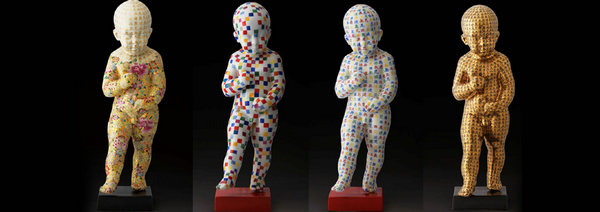 |
|
Figurative sculptures of child made in porcelain by Cimarelli. He combines aesthetic elements of Chinese culture with his Western techniques.DIONISIO CIMARELLI/FOR CHINA DAILY |
In his own art, Cimarelli said he tried to combine aesthetic elements of Chinese culture with his Western techniques.
In 2010, at the invitation of the Italian government, Cimarelli spent more than six months creating a five-foot-tall (1.5 meters) bronze sculpture of Matteo Ricci for the Italy Pavilion at the Shanghai World Expo.
"I've been inspired by the story of Matteo Ricci since I went to China for the first time," Cimarelli said. "And Matteo Ricci was coming from the same region as me, a small city that is very close to where I was born, so the opportunity to make a sculpture of him was a great honor to me."
He said he used Western sculpture materials and techniques and added gilded Chinese calligraphy to the work. The characters are actually Cimarelli's name written in Chinese.
"When I was in Italy, I'd been working a lot with ceramics, and I always liked it a lot," he said. "But when I went to China, I wanted to make something that represents Chinese culture, and when anybody thinks about China, they think about porcelains.
"So, I moved to Jingdezhen (a town in Jiangxi province famous for Chinese porcelain) and opened my own studio and worked there for a couple of years to make my series of porcelain sculptures.
"It was very difficult and challenging for me," added Cimarelli, who had experience in ceramics but knew nothing about Chinese porcelains at the time. "It was totally different."
Since then, he has been making contemporary figurative sculptures in Chinese porcelain. His works include a standing child and a broken African mask, peppered with the gilded calligraphy of his name.
Having witnessed the great changes that reform and opening-up have brought to China, Cimarelli is confident about the benefits the Belt and Road Initiative will bring to both Italy and China in the future.
Italy once played an important role in the ancient Silk Road, and has had a long history of close cultural ties with China since the Middle Ages when Marco Polo (1254-1324) traveled there, he said.
"It's great for trade, as the Silk Road already was fantastic more than two thousand years ago," said Cimarelli. "The exchange between different cultures is like a bridge between peoples.
"We learn from each other and exchange ideas-that is the attitude of Matteo Ricci when he visited China. He didn't go to China for teaching, but for learning."
Cimarelli said he had the same attitude when he visited China-to get exposed to a new culture, to learn from it, to exchange ideas, not to impose his own culture on Chinese people.
"China is like my second home country," Cimarelli said and showed off his Chinese by saying "I love China" in Mandarin.
"Of course I hope to go back to China in the future, anytime, I'm always looking for cooperation and exchange projects."